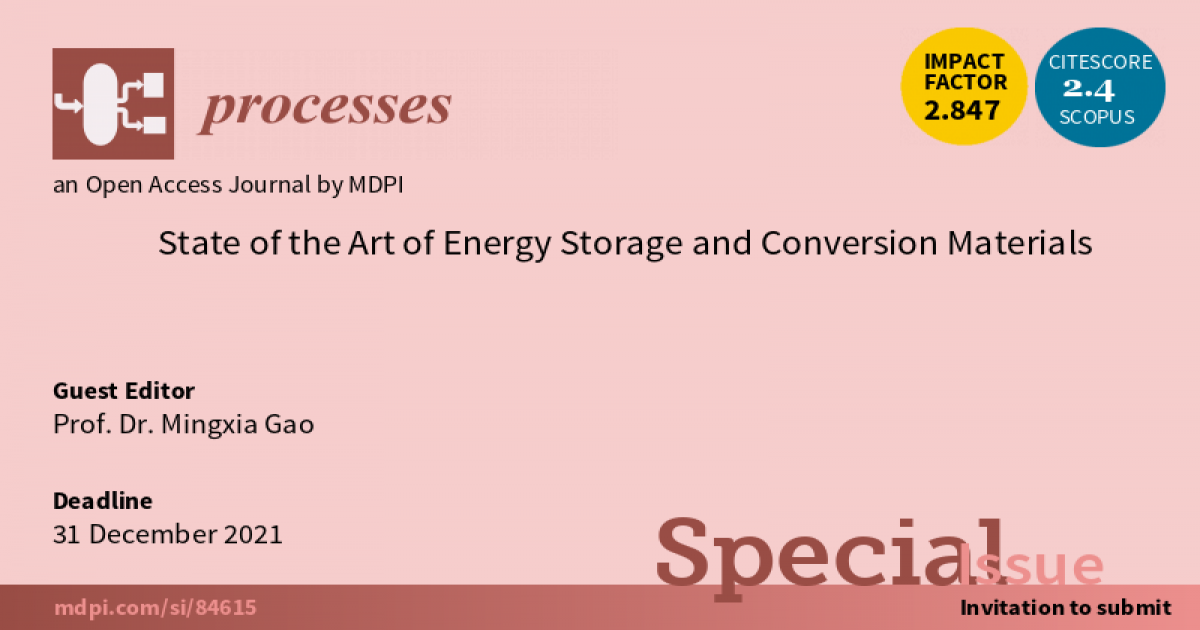State of the Art of Energy Storage and Conversion Materials
A special issue of Processes (ISSN 2227-9717). This special issue belongs to the section "Materials Processes".
Deadline for manuscript submissions: closed (20 May 2022) | Viewed by 44524

Special Issue Editor
Interests: electrode materials for lithium-ion batteries and lithium-sulfur batteries; light–metal hydrogen storage materials and hydrogen storage electrode alloys for Ni/MH batteries; advanced ceramic matrix composites
Special Issue Information
Dear Colleagues,
With the development of modern society, we are suffering increasingly severe problems in terms of energy shortage and environmental pollution. The development of advanced energy storage and conversion materials of large energy capacity and high energy density, advanced environmentally friendly materials, and materials for sustainable renewable energy conversion are extremely urgently needed with regard to solving these problems.
Fuel cells have high energy conversion efficiency. Solid-state hydrogen storage is expected to be a potential hydrogen storage material due to its high volumetric density and safety, which is highly sought after in the application of fuel cells. The development of novel electrocatalysts for oxygen reduction reactions and hydrogen oxidation reactions is extremely important in the development and application of fuel cells. nowadays, lithium–ion batteries are used in a wide variety of areas. Nevertheless, the development of new electrode materials and electrolytes for lithium–ion batteries with high safety, high capacity, high energy density and low costs and other advanced analogous rechargeable secondly batteries is still urgently required, especially with regard to the applications of electron vehicles and hybrid vehicles. Supercapacitors are also important energy conversion technologies, but need to be developed further.
Tremendous efforts have been devoted to the aforementioned materials and their technologies, and significant progress has been achieved; however, they still do not meet the full requirements of practical applications. This Special Issue seeks novel research contributions in, but not limited to, the following areas:
- Hydrogen storage materials, such as metal hydrides, complex hydrides, etc.
- Fuel cells and their technologies;
- Electrode materials and electrolytes for rechargeable secondly batteries, such as lithium–ion batteries, lithium–sulfur batteries; sodium–ion batteries, lithium–air batteries, etc.;
- Electrode materials for supercapacitors, etc.;
- Environmentally friendly materials;
- Materials for sustainable renewable energy conversion.
Reviews, letters and full papers are all permitted.
Prof. Dr. Mingxia Gao
Guest Editor
Manuscript Submission Information
Manuscripts should be submitted online at www.mdpi.com by registering and logging in to this website. Once you are registered, click here to go to the submission form. Manuscripts can be submitted until the deadline. All submissions that pass pre-check are peer-reviewed. Accepted papers will be published continuously in the journal (as soon as accepted) and will be listed together on the special issue website. Research articles, review articles as well as short communications are invited. For planned papers, a title and short abstract (about 250 words) can be sent to the Editorial Office for assessment.
Submitted manuscripts should not have been published previously, nor be under consideration for publication elsewhere (except conference proceedings papers). All manuscripts are thoroughly refereed through a single-blind peer-review process. A guide for authors and other relevant information for submission of manuscripts is available on the Instructions for Authors page. Processes is an international peer-reviewed open access semimonthly journal published by MDPI.
Please visit the Instructions for Authors page before submitting a manuscript. The Article Processing Charge (APC) for publication in this open access journal is 2400 CHF (Swiss Francs). Submitted papers should be well formatted and use good English. Authors may use MDPI's English editing service prior to publication or during author revisions.
Keywords
- hydrogen storage materials
- metal hydrides
- complex hydrides
- hydrogen storage properties
- fuel cells
- oxygen reduction reaction and hydrogen oxidation reaction
- electrocatalysis
- lithium-ion batteries
- sodium-ion batteries
- lithium-sulfur batteries
- lithium-air batteries
- electrode materials
- electrochemical properties
- electrolytes
- supercapacitors
- water electrolysis
- environmentally friendly materials
- materials for sustainable renewable energy conversion
Benefits of Publishing in a Special Issue
- Ease of navigation: Grouping papers by topic helps scholars navigate broad scope journals more efficiently.
- Greater discoverability: Special Issues support the reach and impact of scientific research. Articles in Special Issues are more discoverable and cited more frequently.
- Expansion of research network: Special Issues facilitate connections among authors, fostering scientific collaborations.
- External promotion: Articles in Special Issues are often promoted through the journal's social media, increasing their visibility.
- Reprint: MDPI Books provides the opportunity to republish successful Special Issues in book format, both online and in print.
Further information on MDPI's Special Issue policies can be found here.





